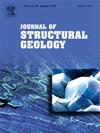由局部流体流入和溶解-沉淀蠕变激活引发的中地壳应变局部化
IF 2.9
2区 地球科学
Q2 GEOSCIENCES, MULTIDISCIPLINARY
引用次数: 0
摘要
了解中地壳变形对于确定应变局域化的时空分布至关重要,这意味着上地壳变形包括地震危险。在此,我们对苏格兰西北部100 m宽的上Badcall剪切带的角闪岩相进行了野外考察,并进行了显微结构和矿物化学分析,该剪切带最初变形为无水石英片麻质和基性岩脉。结果表明,随着应变的增大,m尺度应变分布和矿物化学成分趋于均匀,含水相和同构造石英脉的含量趋于丰富。随着应变的增加,角闪石、斜长石和石英的晶粒尺寸、晶界取向和形状偏好取向总体增加。只有角闪孔和大晶粒石英在应变区表现出晶体学上的优先取向。在其他地方,特别是在长英质片麻岩中,可能被忽视的细微微观结构表明,在基性岩和长英质岩中,溶蚀-沉淀蠕变和等效流变弱化的活动占主导地位。我们认为,现在作为同构造石英脉保存的脆性裂缝允许在以前无水的地壳中局部渗透流体。这引发了局部的倒退反应,并引入了足够的晶界流体进行变形,有利于溶解-沉淀蠕变而不是位错蠕变。我们的研究表明,溶解-降水蠕变在中-下地壳局部变形带可能比以前认为的更占优势。本文章由计算机程序翻译,如有差异,请以英文原文为准。
Mid-crustal strain localisation triggered by localised fluid influx and activation of dissolution–precipitation creep
Understanding mid-crustal deformation is vital for determining the spatial and temporal distribution of strain localisation, with implications for upper-crust deformation including seismic hazard. Here, we conduct fieldwork and microstructural and minerochemical analyses on the amphibolite-facies, 100-m-wide Upper Badcall shear zone in northwest Scotland, which deforms initially anhydrous quartzofeldspathic gneiss and a mafic dyke. We show that with increasing strain, m-scale strain distribution and mineral chemistry become increasingly homogeneous, while hydrous phases and syntectonic quartz veins become more abundant. With increasing strain there is an overall increase in grain size, grain boundary alignment and shape preferred orientation in amphibole, plagioclase and quartz. Only amphibole and large grained quartz exhibit crystallographic preferred orientation in strained areas. Subtle microstructures that may be overlooked elsewhere, particularly in felsic gneiss, indicate dominant activity of dissolution–precipitation creep and equivalent rheological weakening in both mafic and felsic rocks. We propose that brittle fractures, now preserved as syntectonic quartz veins, allowed localised fluid-infiltration in previously anhydrous crust. This triggered local retrogressive reactions and introduced sufficient grain boundary fluid for deformation to favour dissolution–precipitation creep over dislocation creep. Our study suggests that dissolution–precipitation creep may be more dominant in mid- to lower-crustal localised zones of deformation than previously thought.
求助全文
通过发布文献求助,成功后即可免费获取论文全文。
去求助
来源期刊

Journal of Structural Geology
地学-地球科学综合
CiteScore
6.00
自引率
19.40%
发文量
192
审稿时长
15.7 weeks
期刊介绍:
The Journal of Structural Geology publishes process-oriented investigations about structural geology using appropriate combinations of analog and digital field data, seismic reflection data, satellite-derived data, geometric analysis, kinematic analysis, laboratory experiments, computer visualizations, and analogue or numerical modelling on all scales. Contributions are encouraged to draw perspectives from rheology, rock mechanics, geophysics,metamorphism, sedimentology, petroleum geology, economic geology, geodynamics, planetary geology, tectonics and neotectonics to provide a more powerful understanding of deformation processes and systems. Given the visual nature of the discipline, supplementary materials that portray the data and analysis in 3-D or quasi 3-D manners, including the use of videos, and/or graphical abstracts can significantly strengthen the impact of contributions.
 求助内容:
求助内容: 应助结果提醒方式:
应助结果提醒方式:


